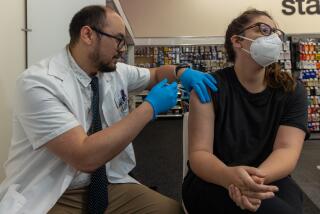Four Die From Meningitis Linked to Flu Outbreak
- Share via
Four people have died in Los Angeles County since Jan. 1 from a virulent form of meningitis that is being linked to what doctors are calling the worst flu season in years.
The deaths, including that of an infant, have been caused by meningococcus, a deadly form of bacteria that can be treated with antibiotics but can kill quickly if not properly diagnosed.
Although the deadly form of meningitis is not related to influenza, it occurs in heavy flu seasons when a person’s immune system may have been weakened by a viral infection, said Dr. Shirley Fannin, director of the county’s disease control programs.
Fannin said the county has had seven people fall ill with the relatively rare form of meningitis this month. The victims’ ages ranged from 5 months to 71 years, and they lived in different parts of the county, Fannin said. Normally, there might be four or five such cases and perhaps one death over a 12-month period, she said.
The deaths came in the midst of what Fannin described as the worst flu season in the last “eight to 10 years.”
The good news is that the flu outbreak may have peaked. Normal flu season runs from late November into February, give or take a few weeks. Physicians and hospitals say they have seen a drop-off in the last few days.
Statewide, the flu problem does not appear to be as severe as it is in Los Angeles County, and even here the outbreak is not extreme enough to be characterized as an epidemic.
Influenza is not a disease that is required to be reported to health authorities, so no one knows how many cases there have been this year compared to the past few years.
The flu can be confused with about 100 other types of viral infections, such as colds, which can cause coughing, sneezing and other flu-like symptoms.
But doctors say influenza often is unmistakable.
“It comes on very abruptly,” said Dr. George Fields, a family doctor at the Mullikin Medical Center in Long Beach. “With a cold, you can work. But with the flu, your whole body aches and you look for the nearest bed.”
The flu not only causes a person to feel awful but can make him or her more susceptible to other infections, including meningitis, a bacterial disease that attacks the membranes surrounding the brain and spinal cord.
Fannin said meningococcal infections claimed the lives of the 5-month-old infant, a 30-year-old woman, a 19-year-old woman and a 34-year-old woman. Survivors are two boys, 14 and 2, and a 71-year-old woman.
She said that if caught in time, the bacterial infection can be treated, but she cautioned that there must be a timely diagnosis.
“You can’t have meningitis and survive unless you get hospitalization and treatment promptly,” Fannin said.
Patients with the classic flu symptoms--coughing, fever, body aches and sneezing--have been filling clinic waiting rooms and flocking to hospital emergency rooms for weeks.
As this year’s influenza outbreak spread, it took a heavy toll in December and carried into January.
“January is always our biggest month for admissions, but this month we have had a rise in admissions that is larger than any year in the last decade,” said David Langness, spokesman for the Healthcare Assn. of Southern California, a regional association of hospitals and physician groups.
At the Kaiser Foundation Hospital in Bellflower, the parade of flu patients got so populous this month that hospital officials established a M.A.S.H.-style unit of two doctors and three nurses and set up a special side door with its own elevator. In the two weeks that the impromptu flu clinic was open, it handled 800 patient visits, about twice what the hospital normally sees.
“We had to do something because of the overwhelming number of flu cases,” said David Hull, the Kaiser administrator who set up the special clinic. “The healthy people appreciated the side door.”
“It’s very unusual for me to see people who have more than the occasional runny nose,” said Dr. Richard Frieder, a Santa Monica obstetrician and gynecologist. “But over the last month or two, everybody has been either sick or getting over something. It just seems like everyone is sick.”
At the Santa Monica-UCLA Medical Center, admissions were up 15% to 25% in November and December, and have jumped another 5% to 10% since Jan. 10.
“We are attributing the increase to the severity of the flu season,” said Ted Braun, a hospital spokesman.
Dr. Eugene Felmar, director of the family practice residency program at the hospital, said those 65 and over were especially hard hit. He said the current strains of influenza appear to be especially virulent.
“We are seeing more cases, and it is lasting longer. People are taking longer to get well,” he said.
More to Read
Sign up for Essential California
The most important California stories and recommendations in your inbox every morning.
You may occasionally receive promotional content from the Los Angeles Times.













